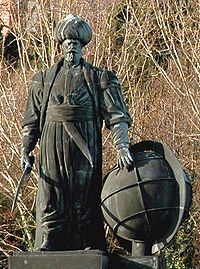This article needs additional citations for verification. (July 2018) |
Dragut | |
|---|---|
 Monument to Turgut Reis in Istanbul depicted with his palm resting on globe. | |
| Native name | Turgut Reis, "Torghoud" |
| Nickname(s) | Dragut Rais, Darghouth Arabic: درغوث Italian: Dragura |
| Born | 1485 Karatoprak, Ottoman Empire (modern Turgutreis, Turkey) |
| Died | 23 June 1565 (aged 79–80) Malta (Siege of Malta) |
| Buried | |
| Allegiance | |
| Service | |
| Years of service | c. 1500–1565 |
| Rank | Admiral, Governor-general, Pasha |
| Commands | Commander-in-Chief of Ottoman Naval Forces in the Mediterranean (Beylerbey) |
| Battles / wars | Battle of Preveza (1538) Sack of Cullera (1550) Invasion of Gozo (1551) Siege of Tripoli (1551) Battle of Ponza (1552) Invasion of Corsica (1553) Sack of Vieste (1554) Sack of Bastia (1555) Raid of the Balearic islands (1558) Battle of Djerba (1560) Sack of Granada (1563) Great Siege of Malta (1565) |
Dragut (Turkish: Turgut Reis; 1485 – 23 June 1565) was an Ottoman corsair, naval commander, governor, and noble. Under his command, the Ottoman Empire's maritime power was extended across North Africa. Recognized for his military genius,[1] and as being among "the most dangerous"[2] of corsairs, Dragut has been referred to as "the greatest pirate warrior of all time",[1] "undoubtedly the most able of all the Turkish leaders", and "the uncrowned king of the Mediterranean". He was nicknamed "the Drawn Sword of Islam".[3][4] He was described by a French admiral as "a living chart of the Mediterranean, skillful enough on land to be compared to the finest generals of the time" and that "no one was more worthy than he to bear the name of king".[3] Hayreddin Barbarossa, who was his mentor, stated that Dragut was ahead of him "both in fishing and bravery".[5]
In addition to serving as Admiral and Corsair in the Ottoman Empire's Navy under Suleiman the Magnificent, Dragut was also appointed Bey of Algiers and Djerba, Beylerbey of the Mediterranean, as well as Bey, and subsequently Pasha, of Tripoli. While serving as Pasha of Tripoli, Dragut constructed great feats in the city, making it one of the most impressive to behold along the entire North African coast.[6]
- ^ a b Judith Miller (28 September 1986). "Malta, Where Suleiman Laid Siege". The New York Times. Retrieved 29 January 2017.
Dragut Reis was respected as the best Moslem seaman of his era, a true pirate, Governor of Tripoli and a military genius. Many historians believe that, had he lived, the siege would have succeeded. His death, however, prompted squabbling between the two senior Ottoman military officers, which led, in turn, to a series of disastrous decisions that helped save the knights. It was on this point... that Dragut was mortally wounded before the fall of St. Elmo when a fragment of rock thrown up by a cannonball struck his head. He would have died instantly had it not been for his thick turban. Death came days later in his tent, shortly after he received news from a messenger that St. Elmo had fallen at last.
- ^ Braudel, Fernand (1995). The Mediterranean and the Mediterranean world in the age of Philip II, Volume 2. University of California Press. pp. 908–909. ISBN 9780520203303.
Of all the corsairs who preyed on Sicilian wheat, Dragut (Turghut) was the most dangerous. A Greek by birth, he was now about fifty years old and behind him lay a long and adventurous career including four years in the Genoese galleys.
- ^ a b Balbi, Francesco (2011). The Siege of Malta, 1565. Boydell Press. pp. 63–64. ISBN 9781843831402.
Born in 1485, he was eighty years old when he came to Malta for the siege. He had been a lieutenant under the famous Barbarossa and, on the latter's death, Dragut became the uncrowned king of the Mediterranean. He was known to his fellow Moslems as 'The Drawn Sword of Islam'. Although in his earlier career he had been at variance with the Sultan Suleiman, the latter had recently recognized Dragut's abilities by confirming him Governor of Tripoli. He knew the Maltese archipelago very well, having raided both islands on several occasions. Among his many successes against the Christians was his capture of Bastia in Corsica (when he had carried off seven thousand captives) and of Reggio in Italy (when he enslaved the whole population of the city). It was Dragut who had captured Tripoli from the Knights of St John in 1551. An old adversary of La Valette, he was undoubtedly the most able of all the Turkish leaders. He was described by a French admiral as 'A living chart of the Mediterranean, skillful enough on land to be compared to the finest generals of the time. No one was more worthy than he to bear the name of king'.
- ^ Rafael Sabatini (2008). The Sword of Islam and Other Tales of Adventure. Wildside Press. p. 7. ISBN 9781434467904.
Ordinarily Dragut Reis – who was dubbed by the Faithful "The Drawn Sword of Islam"
- ^ Pauls, Michael; Facaros, Dana (2000). Turkey. New Holland Publishers. pp. 286–287. ISBN 9781860110788.
It is named after the 16th-century Admiral Turgut (Dragut), who was born here to Greek parents; his mentor Barbarossa, another Greek who 'turned Turk', in a moment of unusual humility declared that Dragut was ahead of him 'both in fishing and bravery'.
- ^ Naylor, Phillip Chiviges (2009). North Africa: a history from antiquity to the present. University of Texas Press. pp. 120–121. ISBN 9780292719224.
One of the most famous corsairs was Turghut (Dragut) (?–1565), who was of Greek ancestry and a protégé of Khayr al-Din. He participated in the successful Ottoman assault on Tripoli in 1551 against the Knights of St. John of Malta. ... While pasha, he built up Tripoli and adorned it, making it one of the most impressive cities along the North African littoral.